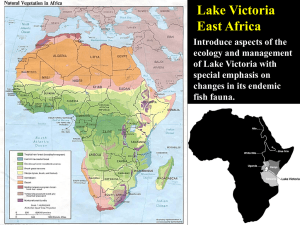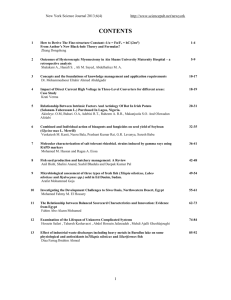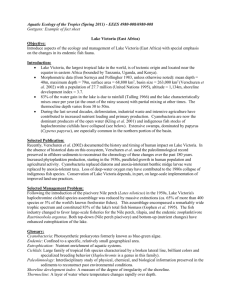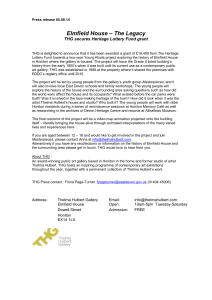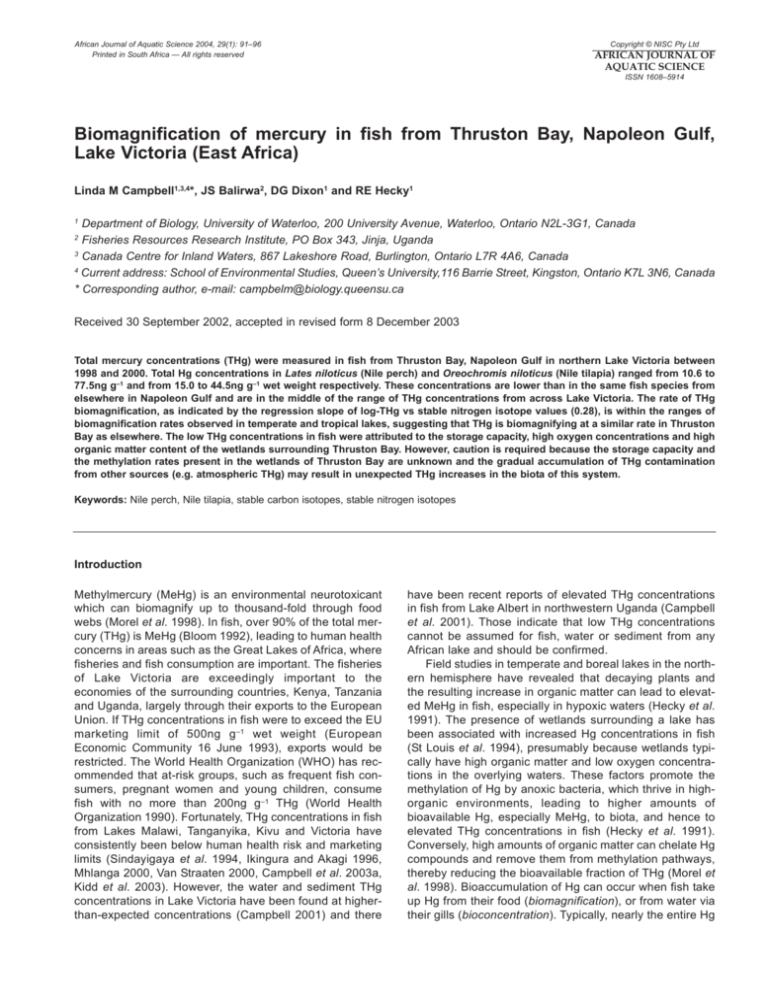
Copyright © NISC Pty Ltd
African Journal of Aquatic Science 2004, 29(1): 91–96
Printed in South Africa — All rights reserved
AFRICAN JOURNAL OF
AQUATIC SCIENCE
ISSN 1608–5914
Biomagnification of mercury in fish from Thruston Bay, Napoleon Gulf,
Lake Victoria (East Africa)
Linda M Campbell1,3,4*, JS Balirwa2, DG Dixon1 and RE Hecky1
Department of Biology, University of Waterloo, 200 University Avenue, Waterloo, Ontario N2L-3G1, Canada
Fisheries Resources Research Institute, PO Box 343, Jinja, Uganda
3
Canada Centre for Inland Waters, 867 Lakeshore Road, Burlington, Ontario L7R 4A6, Canada
4
Current address: School of Environmental Studies, Queen’s University,116 Barrie Street, Kingston, Ontario K7L 3N6, Canada
* Corresponding author, e-mail: campbelm@biology.queensu.ca
1
2
Received 30 September 2002, accepted in revised form 8 December 2003
Total mercury concentrations (THg) were measured in fish from Thruston Bay, Napoleon Gulf in northern Lake Victoria between
1998 and 2000. Total Hg concentrations in Lates niloticus (Nile perch) and Oreochromis niloticus (Nile tilapia) ranged from 10.6 to
77.5ng g–1 and from 15.0 to 44.5ng g–1 wet weight respectively. These concentrations are lower than in the same fish species from
elsewhere in Napoleon Gulf and are in the middle of the range of THg concentrations from across Lake Victoria. The rate of THg
biomagnification, as indicated by the regression slope of log-THg vs stable nitrogen isotope values (0.28), is within the ranges of
biomagnification rates observed in temperate and tropical lakes, suggesting that THg is biomagnifying at a similar rate in Thruston
Bay as elsewhere. The low THg concentrations in fish were attributed to the storage capacity, high oxygen concentrations and high
organic matter content of the wetlands surrounding Thruston Bay. However, caution is required because the storage capacity and
the methylation rates present in the wetlands of Thruston Bay are unknown and the gradual accumulation of THg contamination
from other sources (e.g. atmospheric THg) may result in unexpected THg increases in the biota of this system.
Keywords: Nile perch, Nile tilapia, stable carbon isotopes, stable nitrogen isotopes
Introduction
Methylmercury (MeHg) is an environmental neurotoxicant
which can biomagnify up to thousand-fold through food
webs (Morel et al. 1998). In fish, over 90% of the total mercury (THg) is MeHg (Bloom 1992), leading to human health
concerns in areas such as the Great Lakes of Africa, where
fisheries and fish consumption are important. The fisheries
of Lake Victoria are exceedingly important to the
economies of the surrounding countries, Kenya, Tanzania
and Uganda, largely through their exports to the European
Union. If THg concentrations in fish were to exceed the EU
marketing limit of 500ng g –1 wet weight (European
Economic Community 16 June 1993), exports would be
restricted. The World Health Organization (WHO) has recommended that at-risk groups, such as frequent fish consumers, pregnant women and young children, consume
fish with no more than 200ng g–1 THg (World Health
Organization 1990). Fortunately, THg concentrations in fish
from Lakes Malawi, Tanganyika, Kivu and Victoria have
consistently been below human health risk and marketing
limits (Sindayigaya et al. 1994, Ikingura and Akagi 1996,
Mhlanga 2000, Van Straaten 2000, Campbell et al. 2003a,
Kidd et al. 2003). However, the water and sediment THg
concentrations in Lake Victoria have been found at higherthan-expected concentrations (Campbell 2001) and there
have been recent reports of elevated THg concentrations
in fish from Lake Albert in northwestern Uganda (Campbell
et al. 2001). Those indicate that low THg concentrations
cannot be assumed for fish, water or sediment from any
African lake and should be confirmed.
Field studies in temperate and boreal lakes in the northern hemisphere have revealed that decaying plants and
the resulting increase in organic matter can lead to elevated MeHg in fish, especially in hypoxic waters (Hecky et al.
1991). The presence of wetlands surrounding a lake has
been associated with increased Hg concentrations in fish
(St Louis et al. 1994), presumably because wetlands typically have high organic matter and low oxygen concentrations in the overlying waters. These factors promote the
methylation of Hg by anoxic bacteria, which thrive in highorganic environments, leading to higher amounts of
bioavailable Hg, especially MeHg, to biota, and hence to
elevated THg concentrations in fish (Hecky et al. 1991).
Conversely, high amounts of organic matter can chelate Hg
compounds and remove them from methylation pathways,
thereby reducing the bioavailable fraction of THg (Morel et
al. 1998). Bioaccumulation of Hg can occur when fish take
up Hg from their food (biomagnification), or from water via
their gills (bioconcentration). Typically, nearly the entire Hg
92
burden in fish is from their diet (Morel et al. 1998), therefore food web analyses can provide insights into how Hg is
being biomagnified through the food chain.
The shoreline of Lake Victoria contains many types of
wetlands (Balirwa 1995, 1998), which could create ideal
conditions for the transformation of inorganic Hg to more
biologically active forms, including MeHg. In addition,
increasing eutrophication and hypoxia in the lake may be
leading to increased mercury concentrations in fish. In this
study, we determined THg concentrations of several important fish species from Thruston Bay, which contains a significant proportion of wetland areas, and how it biomagnified through the food web. We also compared THg concentrations in Lates niloticus (Nile perch) and Oreochromis
niloticus (Nile tilapia) with published results to determine
how THg concentrations in Thruston Bay fish compare with
those from other regions away from wetlands.
Campbell, Balirwa, Dixon and Hecky
Jinja
Kafunda sub-Bay
5km
Napoleon Gulf, Uganda
Study area
Thruston Bay, with an area of approximately 1 650 hectares,
is located in the northeastern region of Napoleon Gulf, Lake
Victoria (Figure 1). The mean depth is 5m and the maximum
depth is 11m. In contrast to other nearby bays (e.g.
Fielding), Thruston Bay has a large littoral wetland region
dominated by the macrophytes Cyperus papyrus (papyrus),
Phragmites mauritianus (reeds), Typha domingensis (cattails), Vossia cuspidata (hippo grass) and Eichhornia crassipes (water hyacinth). Three distinct shoreline types can be
distinguished, including a papyrus-dominated sub-bay
(Kafunda Bay), a forested eastern shoreline and a rocky
Phragmites–Vossia stretch to the west. Between 1996 and
1998 about 800ha of Thruston Bay was covered with thick
mats of water hyacinth. However, following the impact of biological control weevils and other environmental factors,
including nutrient depletion and changes in water levels, the
compacted mats collapsed and sank to the bottom of the bay
(Kayanja 2002). Between 1999 and 2000, dissolved oxygen
(DO) levels were between 2.5–5.5mg l–1 (JS Balirwa, unpublished data). In December 2000, surface water quality
parameters in the shallow (<4m) littoral wetland habitats of
the bay were: DO, 4.9mg l–1; conductivity, 110.7µs cm–1; total
phosphorus, 30.6µg l–1; ammonia, 0.5µg l–1; and chlorophylla, 64.3µg l–1 (JS Balirwa, unpublished data).
Methods
Between 1998 and 2000 personnel from the Fisheries
Resources Research Institute (FIRRI) in Jinja set gill nets
overnight at various depths in the littoral regions of Thruston
Bay. See Balirwa (1998) for site and gear descriptions.
Several fish species, including Nile perch, Lates niloticus,
and Nile tilapia, Oreochromis niloticus, were collected (Table
1). All fish were dissected, with a 10cm2 sample of lateral
white muscle being removed from each fish, wrapped in
hydrochloric acid-cleaned aluminum (Al) foil, doublewrapped in self-sealing bags and kept on ice until they could
be transferred to freezers on return to FIRRI laboratories. All
fish were sub-sampled for both stable isotope and mercury
analyses. Three individual Caridina nilotica, a freshwater
Thruston Bay
KENYA
UGANDA
TANZANIA
0
100
200km
Figure 1: Map of Thruston Bay (shaded), and its location in
Napoleon Gulf and Lake Victoria
atyid shrimp, were collected with dip nets and, after removing their gut contents by dissection, were pooled and
wrapped in Al foil for freezing and analysis for stable isotopes.
The frozen samples were shipped to Canada. Total Hg
analyses on the fish samples were performed in the cleanroom laboratory of Dorset Research Centre, Ontario Ministry
of the Environment, Dorset, Ontario. Dry weight samples
were converted to wet-weight samples assuming 80% water
(Campbell 2001). Ultra-clean protocols were employed
throughout the processing (Ontario Ministry of Environment
1999) and are detailed in Campbell et al. (2003a). The Hg
concentration in each biotic sample was determined via
atomic fluorescence spectroscopy using the purge-and-trap
procedure (Ontario Ministry of Environment 1999). Briefly,
the samples were dried, weighed and digested in 2ml of 1:4
nitric-sulphuric acid at 255°C for six hours. Also included
were the National Research Council (Canada) certified reference materials, DORM-2 (4.64 ± 0.26mg Hg kg–1, recovery, 110% to 125%) and DOLT-2 (2.14 ± 0.28mg Hg kg–1,
African Journal of Aquatic Science 2004, 29: 91–96
93
Table 1: Mean ± SD (with range) of total length (TL), weight (Wgt), δ15N, δ13C and THg for fish and Caridina nilotica from Thruston Bay. The
letter codes are used to identify the species in Figures 1 and 2. For C. nilotica, the n of 1 is one sample, not one organism. The subfamily
(SF) Tilapiinae falls within the family Cichlidae
Taxa
Family
Code
n
Lates niloticus
Centropomidae
N
9
Protopeterus aethiopicus
Clarias gariepinus
Haplochromine spp.
Oreochromis leucostictus
Protopteridae
Clariidae
Cichlidae
SF Tilapiinae
A
G
H
L
1
1
1
4
Oreochromis niloticus
SF Tilapiinae
O
8
Tilapia zillii
Caridina nilotica
SF Tilapiinae
Atyidae
Z
C
1
1
TL
(cm)
44.7 ± 24.2
(10.6–77.5)
72.0
83.3
16.0
17.1 ± 0.8
(16.2–18.2)
23.5 ± 9.8
(15.0–44.5)
20.5
–
recovery, 97% to 120%), as well as blanks (<0.5pg total).
The detection limit was 10pg total Hg per sample. Replicate
samples from archived Lake Victoria Nile perch and Nile
tilapia were included in every run to determine between-run
variation, which was 2–7%. The results reported here were
not corrected for recovery. The same methods have been
successfully used in studies of Hg in Lake Victoria
(Campbell et al. 2003a).
To determine food web structure and biomagnification
rates, stable nitrogen and carbon isotope ratios were determined for the fish. Stable nitrogen (δ15N) and carbon (δ13C)
isotope analysis is now a standard technique in food web
studies, and has been successfully applied to aquatic
ecosystem research globally. Typically, δ15N values have
been used to characterise relative trophic position while δ13C
values have been used to determine the sources and flow of
carbon in a food web (Cabana and Rasmussen 1996, Hecky
and Hesslein 1995). The protocols for stable isotope analyses are described in detail in Campbell et al. (2003a). Briefly,
small sub-samples of fish muscle tissue (Table 1) and the
pooled Caridina were dried and ground into fine powder. δ15N
and δ13C analyses were completed concurrently using a
Micromass VG – Isochrom Continuous Flow Isotope Ratio
Mass Spectrometer (CF–IRMS) at the Environmental Isotope
Laboratory, University of Waterloo. The ratios of stable nitrogen isotopes were measured against nitrogen gas in ambient
air, as a reference, while stable carbon isotope ratios are
expressed relative to a PeeDee belemnite standard. The
delta notation (δ) is used to indicate the parts per thousand
(‰) difference in the isotopic ratio of the sample from the reference standard according to the equation:
δ13C or δ15N = [Rsample – Rstandard) / (Rstandard)] x 1 000
where R = 13CO2/12CO2 in belemnite for δ13C or R = 15N/14N
of N2 in air for δ15N.
Analytical standards were inserted in every run and
included both the International Atomic Energy Agency
(IAEA) and in-house walleye and cellulose standards.
Replicates of an archived Lake Victoria Nile perch sample
were included in every run to determine between-run variation. Standard deviations for the standards were ±0.3‰ for
Wgt
(g)
2 029 ± 2 524
(12–6 500)
450
5 042
62
85.8 ± 12.1
(74–102)
421.8 ± 607.9
(66–1 870)
174
–
δ 5N
(‰)
8.9 ± 1.3
(7.2–11.0)
7.8
8.2
8.1
5.4 ± 0.3
(5.0–5.7)
5.7 ± 0.6
(4.9–6.5)
4.9
3.2
δ13C
(‰)
–19.0 ± 0.9
(–20.1 to –17.7)
–22.0
–24.0
–22.2
–21.7 ± 1.1
(–22.9 to –20.6)
–19.5 ± 1.0
(–21.6 to –18.0)
–23.0
–24.4
THg
(ng g–1 ww)
64.1 ± 37.8
(22.9–150.2)
27.2
29.
55.5
1.5 ± 0.7
(0.6–2.2)
12.4 ± 8.5
(1.7–25.7)
3.9
–
δ15N and ±0.2‰ for δ13C, and standard deviations for replicate samples were ±0.16‰ for δ15N and ±0.24‰ for δ13C.
Results and Discussion
Total Hg concentrations ranged from 10.6–77.5ng g–1 in L.
niloticus, and from 15.0–44.5ng g–1 in O. niloticus (Table 1).
The lowest concentrations were generally observed for the
tilapiine species (Oreochromis leucostictus, Tilapia zillii,
and O. niloticus; Table 1). Total Hg concentrations are significantly correlated with weight for L. niloticus and O. niloticus (Table 2). The estimated total length at which THg concentrations reach the European Union marketing limit
(500ng g–1 ww; TL500) for L. niloticus and O. niloticus are
much higher than seen for the same species collected in
Winam or Napoleon Gulfs (Campbell et al. 2003a, Table 2).
Since the TL500 values for these species exceed known maximum lengths, it is not anticipated that L. niloticus and O.
niloticus from Thruston Bay would present a risk to human
consumers or the commercial fisheries. Comparing the THg
concentrations of these two species with other studies from
across Lake Victoria, including Napoleon Gulf (Figure 2, see
review by Campbell et al. 2003b), demonstrates that the
Thruston Bay fish lie within the low to middle range of THg
concentrations for the same fish species from across all of
Lake Victoria.
Plotting δ15N (trophic level) against δ13C (carbon source)
gives a visual characterisation of the food web structure
(Figure 3). Nile perch usually had the highest δ15N values,
indicating higher trophic position than the other fish species.
P. aethiopicus and C. gariepinus, both mixed piscivore/molluscivore species, and the haplochromine species had median δ15N values while the tilapiine species had the lowest δ15N
values. O. niloticus and L. niloticus had heavier δ13C values
than the other species, including P. aethiopicus, C. gariepinus, O. leucosticus and T. zillii, indicating that O. niloticus
and L. niloticus may rely on different carbon sources than
the other fish. This has been observed in both Winam and
Napoleon Gulfs, where L. niloticus and O. niloticus both
tended to have heavier δ13C values than other fish species
(Campbell et al. 2003a). Both δ15N and δ13C are significantly
correlated with total length in L. niloticus (Pearson correla-
94
Campbell, Balirwa, Dixon and Hecky
Table 2: Comparisons of THg (ng g–1 ww) vs total length (TL) regressions for Nile perch (L. niloticus) and Nile tilapia (O. niloticus) specimens
from Thruston Bay with those from Lake Victoria (Napoleon and Winam Gulfs, Campbell et al. 2003a). The TL500, the estimated TL where the
THg concentrations reach 500ng g–1 ww, is given
Species
L. niloticus
L. niloticus
L. niloticus
O. niloticus
O. niloticus
O. niloticus
Site
Thruston Bay
Winam Gulf
Napoleon Gulf
Thruston Bay
Winam Gulf
Napoleon Gulf
Slope
0.002
0.008
0.008
0.032
0.020
0.020
Intercept
1.481
1.138
1.457
0.207
0.393
0.920
r2adj
0.51
0.86
0.94
0.80
0.99
0.94
P value
0.029
<0.001
<0.001
0.002
<0.001
<0.001
TL500 (cm)
609
195
155
188
115
89
(a) Oreochromis niloticus
WHO-recommended limit
N
(Increasing trophic level)
THg (ng/g ww)
10
1
100
(b) Lates niloticus
THg (ng/g ww)
1 000
d15 N ()
10
100
G
8
N
N
N
P
N
N N
O
O
6
L
O
OO
O
O
O
L
L L
Z
N
4
1 000
WEIGHT (g)
C
-24
International marketing limit
WHO-recommended limit
(Lighter)
100
-23
-22
d
-21
13
C ()
-20
-19
-18
(Heavier)
Figure 3: The relationship between δ15N, indicating trophic position,
and δ13C, indicating dietary carbon source, for the fish species collected from Thruston Bay. Each taxon is represented by the code
defined in Table 1
10
10
100
1 000
WEIGHT (g)
10 000
100 000
Figure 2: Total Hg in Oreochromis niloticus (a) and Lates niloticus
(b) from across Lake Victoria, including fish from Thruston Bay (z),
other regions in Uganda (c), Kenya (
) and Tanzania (U). Graph
modified from Campbell et al. (2003b)
tion coefficients, 0.488 and –0.478 respectively). This is consistent with relationships seen for both Winam and Napoleon
Gulfs (Campbell et al. 2003a) and indicates that the
Thruston Bay food web structure is similar to those in other
regions of Lake Victoria.
The slope of the regression of the log-transformed THg
concentrations and δ15N values is used as a useful quantitative measure of biomagnification rate within the food web. In
Thruston Bay, THg is significantly correlated (P ≤ 0.001) with
δ15N values, and the slope is 0.280 (Figure 4). Published log
THg: δ15N slopes from other studies range between 0.17 to
0.48 for temperate lakes (Kidd 1998). In Lake Victoria, the
slopes were 0.163 and 0.165 respectively for Napoleon and
Winam Gulfs (Campbell et al. 2003a), and in Lake Malawi,
the slopes ranged between 0.23 and 0.25 for benthic and
pelagic food webs (Kidd et al. 2003). A study of the food web
in Lake Murray, Papua New Guinea, resulted in a slope of
0.28 for log MeHg:δ15N (Bowles et al. 2001). Exact comparisons of log Hg vs δ15N slopes for diverse food webs are difficult, due to the variability in data and species composition,
but do give an indication of biomagnification power for different ecosystems. The similar ranges of slope values in
tropical and temperate lakes suggest that THg in these
freshwater ecosystems (which is not lost due to volatilisation
or sedimentation) is biomagnified in fish at a relatively consistent rate.
The role of sub-tropical wetlands, such as the Florida
Everglades, in accumulating and methylating mercury is still
African Journal of Aquatic Science 2004, 29: 91–96
95
1 000
THg (ng/g ww)
100
O O
O
OO
10
1
0.1
N
NN N
N
N
N
N
P G
O
Z
O
L
O
L L
L
Log THg = -0.808 + 0.280 (d 15 N); r 2adj = 0.568
5
6
7
d
15
8
9
10
11
N ()
Figure 4: The relationship between THg and d15N values of individual biota from Thruston Bay. Each taxon is represented by the
code defined in Table 1. The regression line is indicated; the regression equation is in the text. Note the use of a log scale for THg concentrations
under extensive review (e.g. Snodgrass et al. 2000), and
even less is known for tropical lacustrine wetlands bordering
large lakes, particularly in Africa. For example, L. niloticus
(18.9 ± 4.0THg ng g–1 ww) and O. niloticus (6.8 ± 0.5ng g–1
THg) from Lake Kyoga, a wetland lake surrounded by
swamps, has some of the lowest measured THg concentrations measured for African fish (LM Campbell, unpublished
data). The Igonzela Swamp, an important wetland feeding
the Smith Arm of Mwanza Gulf in southern Lake Victoria, is
situated near gold processing sites where elemental Hg is
used in gold extraction (Van Straaten 2000). Upstream of the
Igonzela Swamp, stream water has elevated Hg concentrations reaching 400ng l–1, and THg concentrations in C.
gariepinus and P. aethopicus have exceeded WHO-recommended limits of 200ng g–1 and international marketing limits of 500ng g–1. The THg concentrations in the swamp water
entering Smith Sound are ≤100ng l–1 and the same fish
species from the vicinity are below WHO limits (Van Straaten
2000). The lower THg concentrations in fish of Thruston Bay,
Lake Kyoga and Smith Sound indicate the importance of
wetlands in contaminant removal.
The presence of wetlands near a lake environment can,
however, be a two-edged sword. It has been demonstrated
that metal loadings to wetlands near urban areas around
Lake Victoria can exceed the storage capacity of these contaminated wetlands. Once wetlands are saturated with metals, further inputs can be flushed directly to the lake (Onyari
and Wandiga 1989, Kiremire 1998, Makundi 2001). Studies
in temperate regions have shown that the rich organic environments of wetlands can actually promote the methylation
of THg, thereby increasing MeHg loading to lakes (St Louis
et al. 1994). Methylation of Hg compounds occurs with
microorganisms catalysing the reaction forming the covalent
bonds between Hg and CH4. The presence of chloride,
organic compounds and sulfur influences the type of
microorganisms and their ability to take up and methylate Hg
(Morel et al. 1998). Sulfate concentrations and net sulfate
reduction are low in Lake Victoria (Ramlal et al. 2003), which
might ultimately be leading to the low Hg concentrations in
fish from Thruston Bay, despite the rich organic environment
of this wetland bay. However, there is no reason to consider
that THg or MeHg will behave differently in tropical wetlands.
The differences may lie in tropical fish bioenergetics, temperature-influenced methylation rates, higher UV radiation
and the high amounts of organic matter and oxyhydroxides
in Lake Victoria wetlands (Campbell et al. 2003b). More
importantly, the daily exchange and circulation of water in
shallow (<4m deep) wetland zones in Thruston Bay ensures
oxygenated habitats. It is still unknown how these factors
influence the Hg cycle in African lacustrine wetlands, and
this issue should be included in future research.
The THg concentrations in the water of Lake Victoria
(1–10ng l–1) are higher than seen in other Great Lakes in the
northern hemisphere (<1ng l–1, Campbell et al. 2003b). The
major inputs of THg to Lake Victoria have been estimated to
derive from atmospheric sources, most probably biomass
burnings (Campbell 2001). Biomass burnings emit large
amounts of THg, both in Africa and globally (Brunke et al.
2001, Freidli et al. 2001), and a large proportion of global
biomass fires (≥50%) are located in sub-Saharan Africa
(Dwyer et al. 2000). Large-scale biomass burnings still occur
in the Lake Victoria catchment, and the shifting conditions
and possibly limited storage capacity of the Lake Victoria
wetlands necessitate caution and require a better understanding of THg biogeochemistry in order to manage this
situation.
In summary, THg is biomagnifying through the food web
of Thruston Bay at the same rate as elsewhere, but concentrations in Nile perch and Nile tilapia tend to be lower than
those in the same fish species from Napoleon Gulf. This
indicates less bioavailable THg for uptake by biota, and may
be due to the high amounts of organic matter, which can
chelate THg, found in wetlands. The same pattern has been
observed for the wetlands of Ingozela River near Mwanza
Gulf and in Lake Kyoga, which may indicate that there is a
large storage capacity for THg in East African wetland
regions. However, this should not be taken for granted, as
there is no knowledge of the limits of this storage capacity,
and whether it could release biologically available Hg compounds into the lake when the capacity is exceeded. Given
that THg concentrations in Lake Victoria water samples are
relatively high compared to other northern Great Lakes, this
issue needs to be examined in order to prevent any increases in the biota as the Lake Victoria environment changes to
more hypoxic and eutrophic conditions.
Acknowledgements — This study would not have been possible
without the whole-hearted support of the past Directors, Drs R
Ogutu-Ohwayo and F Bugenyi, of the Fisheries Resources
Research Institute, Jinja, Uganda. FIRRI technicians and staff (I
Musana, M Nsega, G Magezi, E Muhumuza, J Luyiga) assisted with
the sample collection and fish processing. Dr Greg Mierle lent laboratory space and the use of Hg analysis equipment in the clean
room laboratory at Dorset Environmental Research Centre, Ontario
Ministry of Environment. William Mark processed stable isotope
samples at the Environmental Isotope Laboratory, University of
Waterloo. Financial support was provided by two International
96
Development Research Council Doctorate Awards, an Ontario
Provincial Graduate Sciences and Technology Scholarship and
Davis Memorial Ecology Scholarship to LMC, as well as NSERC
Research Grants to REH and DGD.
References
BALIRWA JS (1995) The Lake Victoria environment: Its fisheries and
wetlands — a review. Wetlands Ecology and Management 3:
209–224.
BALIRWA JS (1998) Lake Victoria Wetlands and the Ecology of the
Nile Tilapia, Oreochromis niloticus Linne? PhD Thesis,
Wagengen Agricultural University, The Netherlands, 247pp. ISBN
90 5410 411 2.
BLOOM NS (1992) On the chemical form of mercury in edible fish and
marine invertebrate tissue. Canadian Journal of Fisheries and
Aquatic Sciences 49: 1010–1017.
BOWLES KCS, APTE C, MAHER WA, KAWEI M and SMITH R (2001)
Bioaccumulation and biomagnification of mercury in Lake Murray,
Papua New Guinea. Canadian Journal of Fisheries and Aquatic
Sciences 58: 888–897.
BRUNKE EG, LABUSCHAGNE C and SLEMR F (2001) Gaseous mercury
emissions from a fire in the Cape Penisula, South Africa during
January 2000. Geophysical Research Letters 28: 1483–1486.
CABANA G and RASMUSSEN JB (1994) Modelling food chain structure
and contaminants using stable nitrogen isotopes. Nature 372:
255–373.
CAMPBELL LM (2001) Mercury in Lake Victoria, East Africa: Another
Emerging Issue for a Beleaguered Great Lake? PhD Thesis,
Biology, University of Waterloo, Waterloo, Ontario, Canada,
146pp.
CAMPBELL LM, HECKY RE, WANDERA SB and DIXON DG (2001)
Elevated mercury concentrations in remote Lake Albert, Uganda,
East Africa. Proceedings of the 6th International Conference on
Mercury as a Global Pollutant. 15–19 October 2001, Minamata,
Japan.
CAMPBELL LM, HECKY RE, NYAUNDI J, MUGGIDE R and DIXON DG
(2003a) Distribution and food-web transfer of mercury in
Napoleon and Winam Gulfs, Lake Victoria, East Africa. Journal of
Great Lakes Research 29 (Suppl. 2): 267–282.
CAMPBELL LM, HECKY RE and DIXON DG (2003b) Review of mercury
in Lake Victoria (East Africa): Implications for human and ecosystem health. Journal of Toxicology and Environmental Health, Part
B 6: 325–356.
DWYER E, PINNOCK S, GRÉGOIRE H-M and PEREIRA JMC (2000)
Global spatial and temporal distribution of vegetation fire as
determined from satellite observations. International Journal of
Remote Sensing 21: 1289–1302.
EUROPEAN ECONOMIC COMMUNITY (16 June 1993) Commission
Decision of 19 May 1993 determining analysis methods, sampling
plans and maximum limits for mercury in fishery products. EEC,
Brussels, Belgium. No. 393D0351 93/351/EEC. Available at:
http://europa.eu.int/eur-lex/en/lif/dat/1993/en_393D0351.html
FREIDLI HR, RADKE LF and LU JY (2001) Mercury in smoke from biomass fires. Geophysical Research Letters 28: 3223–3226.
HECKY RE and HESSLEIN RH (1995) Contributions of benthic algae to
lake food webs as revealed by stable isotope analyses. North
American Journal of Benthological Society 14: 631–653.
HECKY RE, RAMSEY DJ, BODALY RA and STRANGE NE (1991)
Increased methylmercury contamination in fish in newly formed
freshwater reservoirs. In: Suzuki T, Imura N and Clarkson TW
(eds) Advances in Mercury Toxicology. Plenum Press, New York,
pp 33–52.
Campbell, Balirwa, Dixon and Hecky
IKINGURA JR and AKAGI H (1996) Monitoring of fish and human exposure to mercury due to gold mining in the Lake Victoria goldfields,
Tanzania. The Science of the Total Environment 191: 59–68.
KAYANJA FIB (ed.) (2002) Experiences with managing water hyacinth
infestation in Uganda. National Agricultural Research
Organization, Jinja, Uganda, 100pp.
KIDD KA (1998) Use of Stable Isotope Ratios in Freshwater and
Marine Biomagnification Studies. In: Rose J (ed) Environmental
Toxicology. Science Publishers, Amsterdam, The Netherlands, pp
357–376.
KIDD KA, BOOTSMA HA, HESSLEIN RH, LOCKHART L and HECKY RE
(2003) Mercury concentrations in the foodweb of Lake Malawi,
East Africa. Journal of Great Lakes Research 29: 258–266.
KIREMIRE BT (1998) Management of chemicals — Uganda:
93–8483. Department of Chemistry, Makerere University Report
No. 93–8483, Kampala, Uganda.
MAKUNDI IN (2001) A study of heavy metal pollution in Lake Victoria
sediments by energy dispersive X-ray fluorescence. Journal of
Environmental Science and Health A36: 909–921.
MHLANGA W (2000) Mercury in tigerfish (Hydrocynus vittatus,
Castelnau), green happy (Sargochromis codringtonii, Boulenger)
and kapenta (L imnothrissa miodon, Boulenger) from Lake
Kariba, Zimbabwe. African Journal of Ecology 38: 224–229.
MOREL FM, KRAEPIEL MAML and AMYOT M (1998) The chemical cycle
and bioaccumulation of mercury. Annual Reviews of Ecology and
Systematics 29: 543–566.
ONTARIO MINISTRY OF ENVIRONMENT (1999) Automated Determination
of Total Mercury at Ultratrace Levels in Environmental Samples.
Laboratory Services Branch, Ontario Ministry of Environment,
Toronto, Ontario, Canada
ONYARI JM and WANDIGA SO (1989) Distribution of Cr, Pb, Cd, Zn, Fe
and Mn in Lake Victoria sediments, East Africa. Bulletin of
Environmental Contamination and Toxicology 42: 807–813.
RAMLAL PS, BUGENYI FWB, KLING GW, NRIAGU JO, RUDD JWM and
CAMPBELL LM (2003). Lake Victoria, East Africa: Mercury concentrations in water, sediment and biota. Journal of Great Lakes
Research 29: 283–291.
SINDAYIGAYA E, VAN CAUWENBERGH R, ROBBERECHT H and D DEELSTRA
H (1994) Copper, zinc, manganese, iron, lead, cadium, mercury
and arsenic in fish from Lake Tanganyika, Burundi. The Science
of the Total Environment 144: 103–115.
SNODGRASS JW, JAGOE CH, BRYAN AL, BRANT HA and BURGER J
(2000) Effects of trophic status and wetland morphology,
hydroperiod, and water chemistry on mercury concentrations in
fish. Canadian Journal of Fisheries and Aquatic Sciences 57:
171–180.
ST LOUIS V, RUDD JWM, KELLY CA, BEATY KG, BLOOM NS and FLETT
RJ (1994) Importance of wetlands as sources of methyl mercury
to boreal forest ecoystems. Canadian Journal of Fisheries and
Aquatic Sciences 51: 1065–1076.
VAN STRAATEN P (2000) Mercury contamination associated with
small-scale gold mining in Tanzania and Zimbabwe. The Science
of the Total Environment 259: 105–113.
WORLD HEALTH ORGANIZATION (1990) IPCS Environmental Health
Criteria 101: Methylmercury. International Programme of
Chemical Safety, World Health Organization, Geneva,
Switzerland, 144pp.

